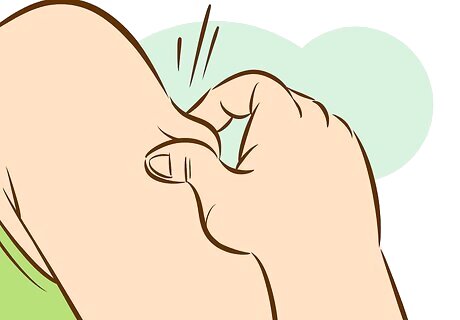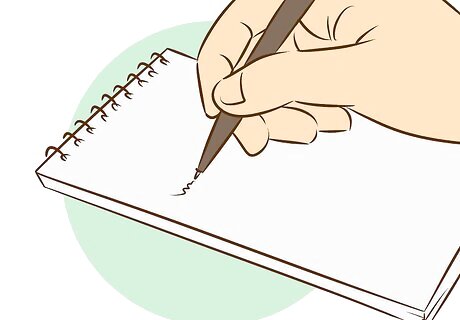
views
Distancing Yourself

Take a few deep breaths. Breathing deeply will help your body relax, releasing the tension that would otherwise build up and spill out as tears. Try focusing on your breath, inhaling and exhaling slowly to the count of 4.

Look off to the side. When you are having a conversation with someone and you feel tears coming on, look away for a minute. Find a spot on the wall to focus on, or look at your hands intently. Remove yourself from the situation momentarily (just one minute will do) to give yourself space to gather your thoughts.

Take a step backward. Put some literal distance between you and the situation or person making you cry. Taking a step backward can give you a bit of personal space in which to gather your thoughts (and tears).

Take a walk. Remove yourself physically from the situation that’s making you cry and take a walk. Focus on moving your arms and legs, and try to regularize your breathing. If you want to stop crying, don’t retreat to the bathroom; you might cry more there.

Focus your attention on something else. Grab a magazine or watch a funny video. Pull yourself away from the immediate feelings that are making tears well up. Deliberately focus on the concrete details of what you’re reading or watching, and comment on details to yourself, such as, “That is a gorgeous dress,” or “I can’t believe that cat jumped so high.”
Changing Your Response

Give a smile. Forcing yourself to smile when you feel the opposite will help you overcome negative feelings. Your mood will lift and stress will be reduced even if you fake a smile, as your body tricks your mind into thinking you are happy.

Keep a neutral expression on your face. Relax your crumpled up forehead and tensed mouth and cheeks. By installing a neutral expression on your face, you are forcing your body out of the immediate crying mode.

Shift your emotion to anger. Many times, you might start crying because you are trying to hold in your true emotions. It’s often not considered appropriate to get angry during a conflict, and crying can come because adrenaline is flowing and you’ve stuffed down your anger. Allow yourself to identify angry feelings and announce them. Often, women don’t feel like they are allowed to get angry at the risk of being labeled a *****. Skip this feeling and give yourself permission to get angry. You don’t have to be aggressively angry to show that you’re angry. Even saying something like, “I’m angry that I haven’t had a chance to participate fully,” can help you name your feelings and keep from crying.

Be prepared with something to say. Have a response in mind for certain types of situations. If you seem to cry easily when you receive criticism from your boss, for example, think about ways to respond verbally to this feedback. Being prepared with something to say, even with a canned response, can help steer you away from crying.
Trying Physical Strategies

Pinch yourself. Distract yourself away from your oncoming tears by causing a very small amount of physical discomfort to your body. Pinch your arm to redirect your mind from your tears.

Alternately, try biting the inside of your cheek. Try to be gentle so that you don’t draw blood. You can also press your fingernails into the palm of your hand.

Pinch the bridge of your nose. Squeeze your thumb and forefinger on the bridge of your nose, right near your eyes. This will slow down your tear ducts from producing tears.

Widen your eyes and look up. Open up your eyes really wide, which can help dry them out. Looking up while you do this will help any forming tears sink back away from the rims of your eyes.

Press your tongue against the roof of your mouth. Tightening your mouth muscles and focusing on pressing your tongue upwards can help stop you from tearing up.

Try swallowing. Swallowing will help constrict the muscles in your throat. Crying helps open the muscles, so if you can do the opposite, you may be able to restrict the crying response., Taking a drink of water can also achieve the same effect.
Changing Your Health Habits

Get some exercise. Try going for a jog or a bike ride to pull yourself out of the situation that’s making you cry. Exercising will increase oxygen flow to the brain and will release endorphins that will calm you down.

Eat nutrient-rich foods. Feed your body with good foods in order to give yourself energy and strength to fight off negative feelings. Eat proteins and cut down on refined sugars and refined carbohydrates. Eat a good breakfast every morning. This will help stabilize your blood sugar and your mood. Increase your intake of folic acid, which can be found in leafy green vegetables.

Get plenty of rest. If you are tired, you are often not able to handle strong feelings as well. Being short on sleep will make it more difficult to hold back the tears. Aim to get 7-8 hours of sleep in order to smooth out your nerves.
Trying Other Methods

Talk with a counselor. Seeking professional help can give you an important outlet for understanding why you’re crying in certain situations. A counselor might be able to help you figure out how to communicate more effectively so that you don’t end up crying so often. This person might also help you get to the root of why you feel like crying.

Talk with a trusted friend or family member. Confide in someone you trust by talking about some of the issues that cause you to cry. Whether it’s work conflict or a relationship problem, it can help to talk through the problem so that you gain some perspective.

Keep a journal. Writing down your thoughts in a journal can be therapeutic and can allow you to announce and explore feelings that you’re experiencing. This is a good way to work through stressors in your life and to strategize ways to control unwanted crying.

Try acupressure. Acupressure is a traditional Chinese healing method that involves pressing on different parts of your body to achieve relief and healing of certain health symptoms. Try some of the acupressure techniques associated with relieving anxiety, which is often the source of unwanted crying. Press the spot right in between your eyebrows. Apply pressure to this spot for 1-3 minutes. Press on your inner wrist. Lay three fingers on your wrist, with your ring finger on the crease of your wrist. Feel for the space between the two tendons on your wrist just underneath your index finger. Apply pressure here to feel relief from anxiety and crying. Pinch the webbing in between your thumb and index finger.


















Comments
0 comment